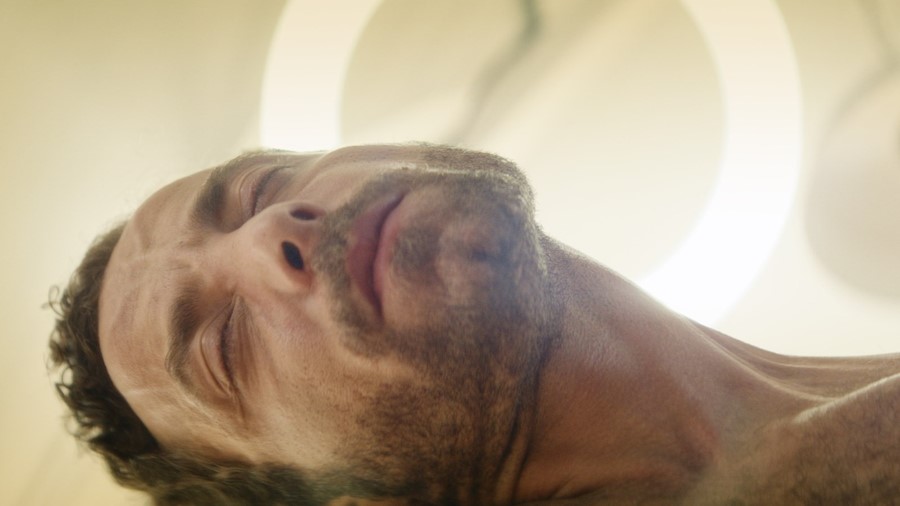Director Kaouther Ben Hania and actor Yahya Mahayni delve into their film The Man Who Sold His Skin, which is inspired by the true story of Tim Steiner
The Man Who Sold His Skin, the brilliant, Oscar-nominated film from Tunisian director Kaouther Ben Hania, could almost have been called The Man Who Sold His Soul. Yahya Mahayni stars as Sam Ali, a Syrian refugee who enters into a deeply unsettling arrangement with Jeffrey Godefroi (Koen De Bouw), a rich and wilfully provocative artist. Having fled to safety in Beirut, educated Sam finds himself stuck in a mundane job vaccinating chickens, but Jeffrey and his chilly assistant Soraya (Monica Bellucci) offer him a way out. If Jeffrey turns Sam into a living work of art by tattooing an EU visa on his back – an image, of course, that is cruelly loaded with irony – they will sort the paperwork so Sam can follow his former fiancée Abeer (Dea Liane) to Brussels. The catch? Sam will have to sit still and silent in an art gallery each day as part of Jeffrey’s latest exhibition.
Mahayni’s beautifully nuanced performance conveys all of Sam’s desperation, bravery, debasement and determination. Sam doesn’t agree to Jeffrey’s deal naively, but neither does he fully appreciate its potential to dehumanise him. “He’s under duress of circumstances,” the actor says, pointing out that Sam’s tipping point comes during a Zoom call with Abeer, when he sees his former lover reluctantly embracing the wealthy man she was forced to marry. “We’ve all been in positions where we’ve taken decisions which are contrary to our principles but which we justified as a means to an end. Sam knows he is going to be selling part of his dignity, but he didn’t realise this would happen as early as it does.” Indeed, it happens even before Sam is installed as a living, breathing artwork in the Belgian gallery. During a pre-exhibition photo shoot, he is told the photographer has no time to take a few extra shots for Sam to send to his mother. “And then bit by bit he realises, ‘You know, I’m actually nothing in these people’s eyes,’” Mahayni says. “He realises the only value that they attribute to him is the work on his back.”

Ben Hania’s film is inspired by the true story of Tim Steiner, a former tattoo parlour manager who was transformed into a human work of art by the Belgian artist Wim Delvoye. Unlike Ben Hania’s protagonist, Steiner didn’t enter into the arrangement under any apparent duress; he also seems content to spend portions of his life posing in art galleries. “The work of art is on my back, I’m just the guy carrying it around,” he said humbly in a 2017 interview. Ben Hania has described Steiner’s story as the “trigger” for her film, telling Screen Daily last year: “I started thinking about this guy who gets himself tattooed and the impact it has on his life but it was just a framework, it needed a story to nourish it. The story of the refugee came after but both worlds carry equal weight.” Today, Mahayni says he has heard “so many views” about the film’s purpose, but bristles when someone suggests it’s simply a “criticism of western society and its treatment of refugees.” “I don’t think this film can be reduced to an east versus west [narrative],” he says. “For me, it’s more about the way we overvalue money over humanity. But I can sympathise with someone who might have interpreted that way, because this film is really so subjective.”
The film feels subjective, in part, because Ben Hania and Mahayni make Sam such a complicated protagonist. Even his relationship with the maverick artist – a man who initially appears to hold all the power – is ultimately defined by a mutual respect. “It starts out as a sort of vertical relationship, but it’s kind of flattened out [by the end],” Mahayni says. “You know, they start joking together and come to understand each other at some point.” The actor also suggests it is no accident Jeffrey picks Sam as his subject to begin with. “He knew [Sam] would be hot-headed and that would make for a more interesting and compelling work of art,” the actor says. “For Jeffrey, it’s an extra way of playing the system, which is what he’s interested in doing as an artist.”
Before its surprising and twisty final act, Ben Hania’s film succeeds in satirising the pretentious elements of the contemporary art world: inevitably, Sam attracts the interest of a callous collector who dehumanises him less knowingly than Jeffrey. But it’s not the film’s wit or narrative trickery that lingers longest of all. The Man Who Sold His Skin is fascinating because it makes us question the relative value we attribute to our fellow human beings. If the system that keeps Sam and Jeffrey in their respective places is rigged, aren’t we all just helping to perpetuate it?
